Abstract
Pulmonary mechanical function and gas exchange were studied in 33 patients with advanced pulmonary vascular disease, resulting from primary pulmonary hypertension in 18 cases and from Eisenmenger physiology in 15 cases. Evidence of airway obstruction was found in most patients. In addition, mean total lung capacity (TLC) was only 81.5% of predicted and 27% of our subjects had values of TLC less than one standard deviation below the mean predicted value. The mean value for transfer factor (TLCO) was 71.8% of predicted and appreciable arterial hypoxaemia was present, which was disproportionate to the mild derangements in pulmonary mechanics. Patients with Eisenmenger physiology had significantly lower values of arterial oxygen tension (PaO2) (p less than 0.05) and of maximum mid expiratory flow (p less than 0.05) and significantly higher pulmonary arterial pressure (p less than 0.05) than those with primary pulmonary hypertension, but no other variables were significantly different between the two subpopulations. It is concluded that advanced pulmonary vascular disease in patients with primary pulmonary hypertension and Eisenmenger physiology is associated not only with severe hypoxaemia but also with altered pulmonary mechanical function.
Full text
PDF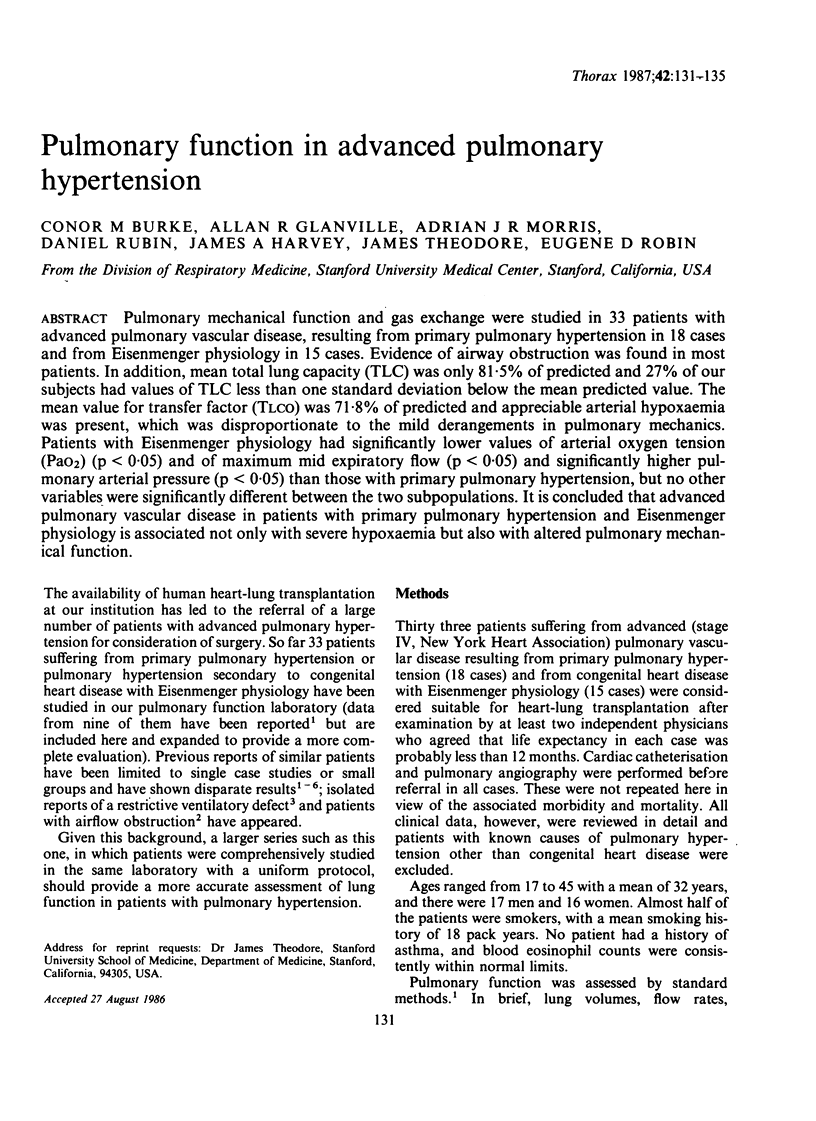
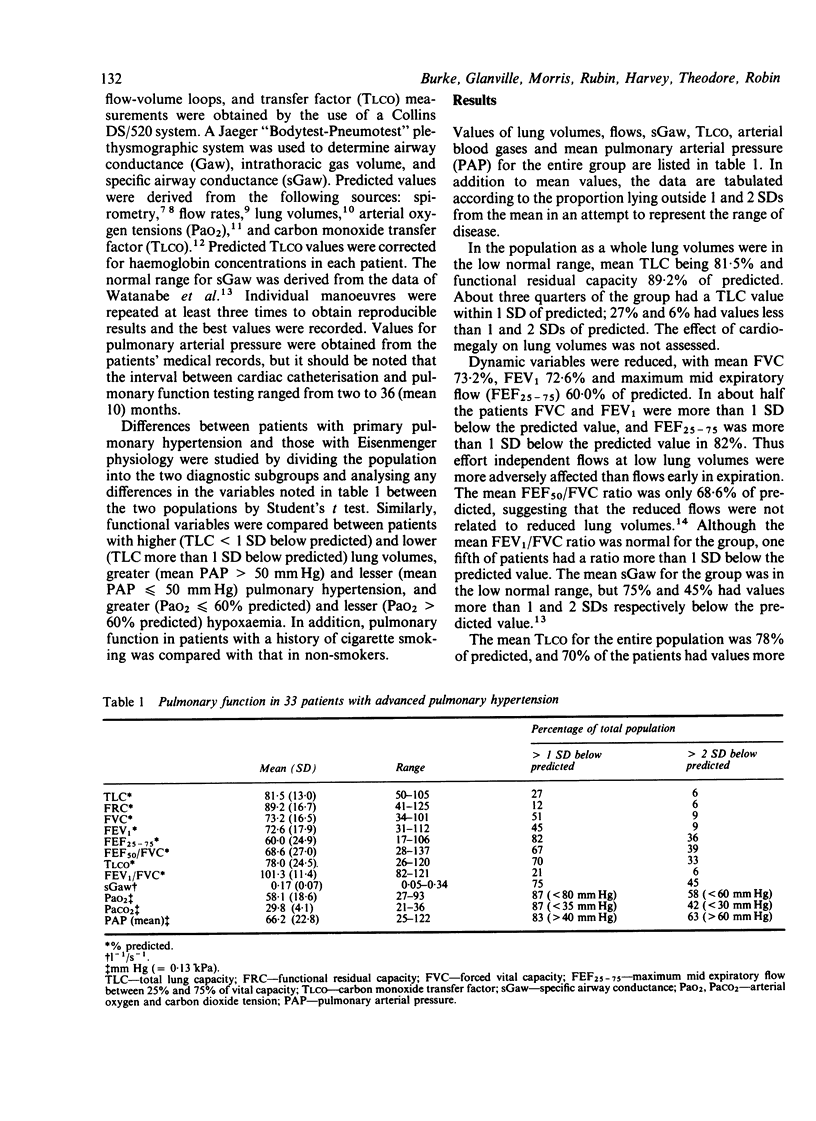
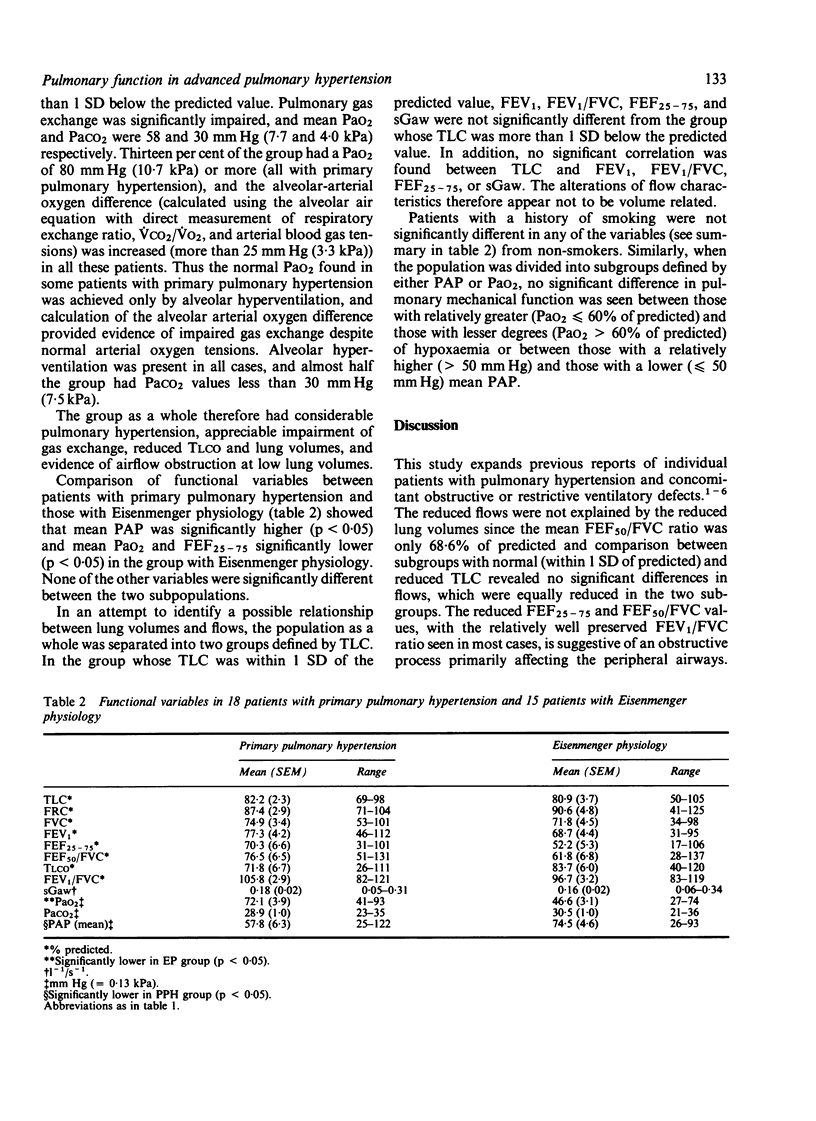
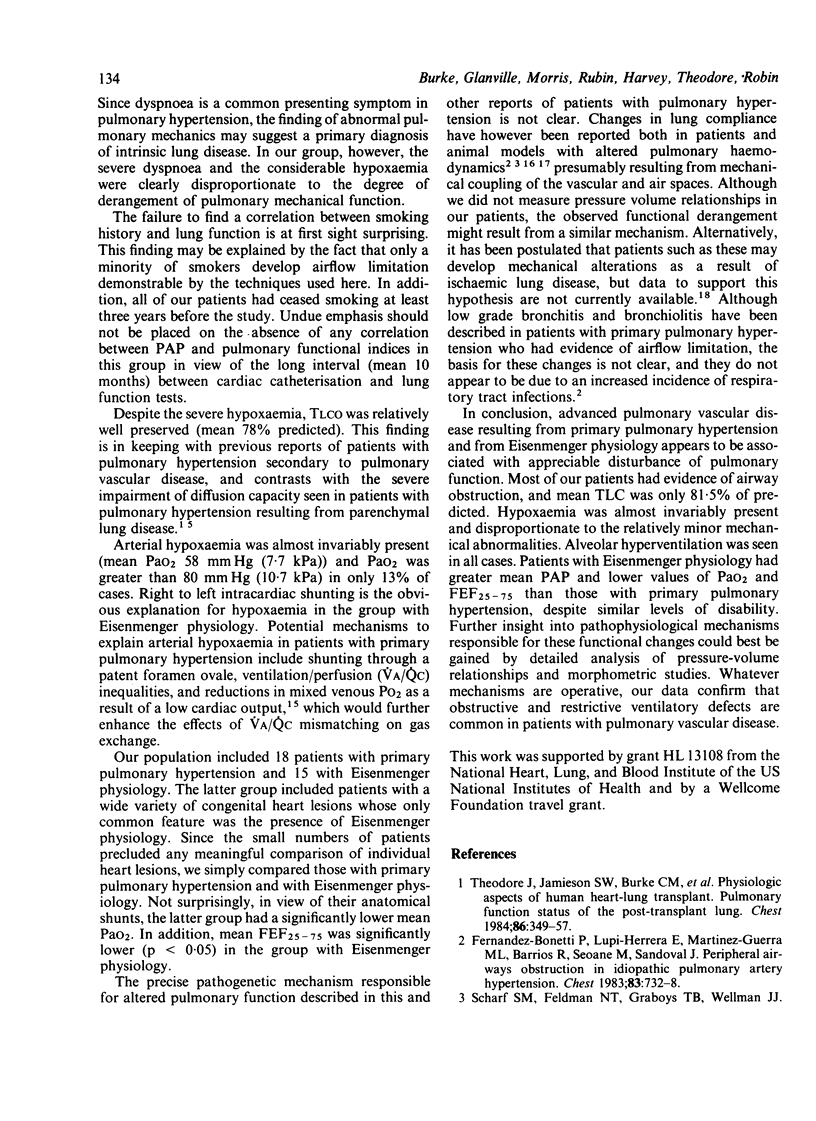
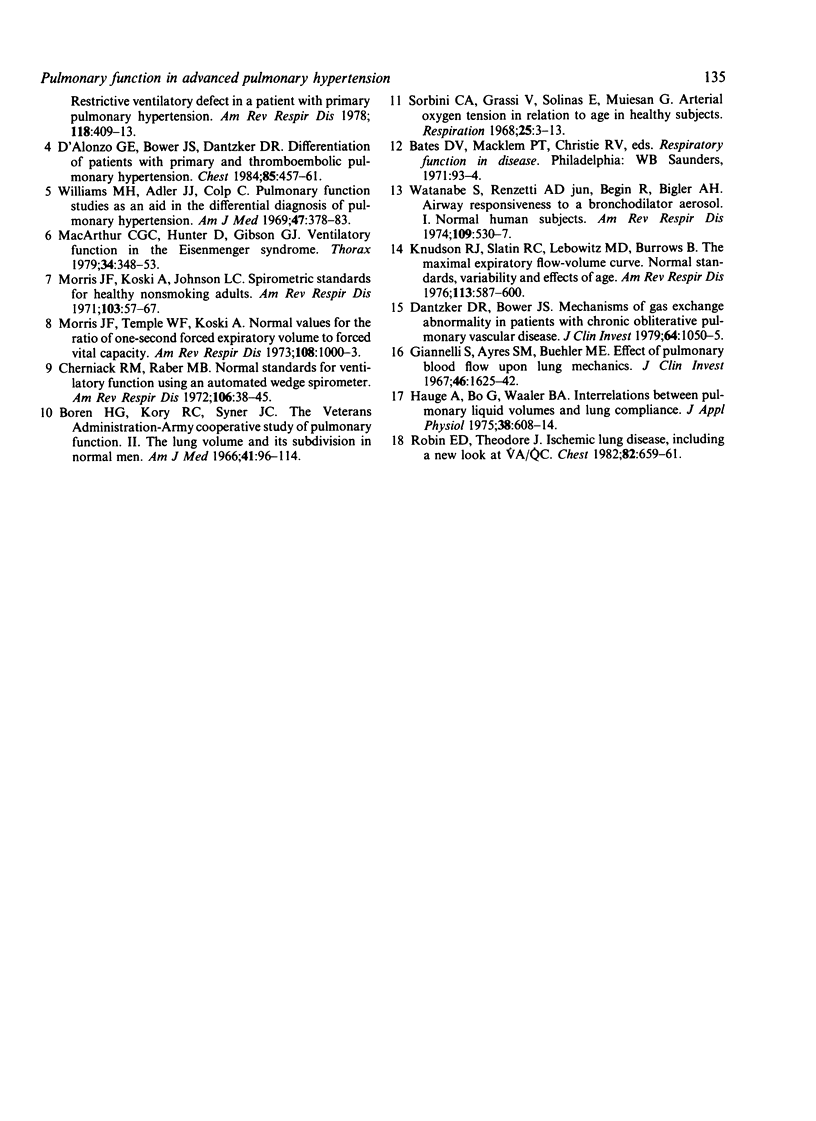
Selected References
These references are in PubMed. This may not be the complete list of references from this article.
- Cherniack R. M., Raber M. B. Normal standards for ventilatory function using an automated wedge spirometer. Am Rev Respir Dis. 1972 Jul;106(1):38–46. doi: 10.1164/arrd.1972.106.1.38. [DOI] [PubMed] [Google Scholar]
- D'Alonzo G. E., Bower J. S., Dantzker D. R. Differentiation of patients with primary and thromboembolic pulmonary hypertension. Chest. 1984 Apr;85(4):457–461. doi: 10.1378/chest.85.4.457. [DOI] [PubMed] [Google Scholar]
- Dantzker D. R., Bower J. S. Mechanisms of gas exchange abnormality in patients with chronic obliterative pulmonary vascular disease. J Clin Invest. 1979 Oct;64(4):1050–1055. doi: 10.1172/JCI109542. [DOI] [PMC free article] [PubMed] [Google Scholar]
- Fernandez-Bonetti P., Lupi-Herrera E., Martinez-Guerra M. L., Barrios R., Seoane M., Sandoval J. Peripheral airways obstruction in idiopathic pulmonary artery hypertension (primary). Chest. 1983 May;83(5):732–738. doi: 10.1378/chest.83.5.732. [DOI] [PubMed] [Google Scholar]
- Giannelli S., Jr, Ayres S. M., Buehler M. E. Effect of pulmonary blood flow upon lung mechanics. J Clin Invest. 1967 Oct;46(10):1625–1642. doi: 10.1172/JCI105655. [DOI] [PMC free article] [PubMed] [Google Scholar]
- Hauge A., Bø G., Waaler B. A. Interrelations between pulmonary liquid volumes and lung compliance. J Appl Physiol. 1975 Apr;38(4):608–614. doi: 10.1152/jappl.1975.38.4.608. [DOI] [PubMed] [Google Scholar]
- Knudson R. J., Slatin R. C., Lebowitz M. D., Burrows B. The maximal expiratory flow-volume curve. Normal standards, variability, and effects of age. Am Rev Respir Dis. 1976 May;113(5):587–600. doi: 10.1164/arrd.1976.113.5.587. [DOI] [PubMed] [Google Scholar]
- MacArthur C. G., Hunter D., Gibson G. J. Ventilatory function in the Eisenmenger syndrome. Thorax. 1979 Jun;34(3):348–353. doi: 10.1136/thx.34.3.348. [DOI] [PMC free article] [PubMed] [Google Scholar]
- Morris J. F., Koski A., Johnson L. C. Spirometric standards for healthy nonsmoking adults. Am Rev Respir Dis. 1971 Jan;103(1):57–67. doi: 10.1164/arrd.1971.103.1.57. [DOI] [PubMed] [Google Scholar]
- Morris J. F., Temple W. P., Koski A. Normal values for the ratio of one-second forced expiratory volume to forced vital capacity. Am Rev Respir Dis. 1973 Oct;108(4):1000–1003. doi: 10.1164/arrd.1973.108.4.1000. [DOI] [PubMed] [Google Scholar]
- Robin E. D., Theodore J. Ischemic lung disease, including a new look at Va/Qc. Chest. 1982 Dec;82(6):659–661. doi: 10.1378/chest.82.6.659. [DOI] [PubMed] [Google Scholar]
- Scharf S. M., Feldman N. T., Graboys T. B., Wellman J. J. Restrictive ventilatory defect in a patient with primary pulmonary hypertension. Am Rev Respir Dis. 1978 Aug;118(2):409–413. doi: 10.1164/arrd.1978.118.2.409. [DOI] [PubMed] [Google Scholar]
- Sorbini C. A., Grassi V., Solinas E., Muiesan G. Arterial oxygen tension in relation to age in healthy subjects. Respiration. 1968;25(1):3–13. doi: 10.1159/000192549. [DOI] [PubMed] [Google Scholar]
- Theodore J., Jamieson S. W., Burke C. M., Reitz B. A., Stinson E. B., Van Kessel A., Dawkins K. D., Herran J. J., Oyer P. E., Hunt S. A. Physiologic aspects of human heart-lung transplantation. Pulmonary function status of the post-transplanted lung. Chest. 1984 Sep;86(3):349–357. doi: 10.1378/chest.86.3.349. [DOI] [PubMed] [Google Scholar]
- Watanabe S., Renzetti A. D., Jr, Begin R., Bigler A. H. Airway responsiveness to a bronchodilator aerosol. I. Normal human subjects. Am Rev Respir Dis. 1974 May;109(5):530–537. doi: 10.1164/arrd.1974.109.5.530. [DOI] [PubMed] [Google Scholar]
- Williams M. H., Jr, Adler J. J., Colp C. Pulmonary function studies as an aid in the differential diagnosis of pulmonary hypertension. Am J Med. 1969 Sep;47(3):378–383. doi: 10.1016/0002-9343(69)90221-6. [DOI] [PubMed] [Google Scholar]


